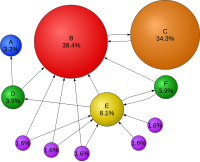
Photo from wikipedia
Modern retail chains, such as Starbucks and McDonald’s, seek for geographical locations that have higher possibility to bring the maximum profit to establish and open their new stores. For a… Click to show full abstract
Modern retail chains, such as Starbucks and McDonald’s, seek for geographical locations that have higher possibility to bring the maximum profit to establish and open their new stores. For a retail store, the common indicator of profit is its popularity which can be measured by the number of people who had ever consumed there. If one can know the potential popularity of locations along the time or within a certain time period (e.g., Christmas holiday or some memorial days) in advance, it would facilitate the determination of locations that are more profitable for the geographical placement of new retail stores. In this paper, given a targeted retail chain as well as some candidate locations, we propose to predict the popularity values of these locations over time to support their decisions on placing new stores. We devise a semi-supervised learning model, Affinity-based Popularity Inference, to tackle the Temporal Location Popularity Prediction problem. The basic idea is that locations that share similar properties of geo-spatial venue characteristics and human mobility tend to have closer popularity values. Experiments conducted on Foursquare check-in data in New York City exhibit promising results on predicting the temporal popularity of retail chains Starbucks, McDonald’s, and Dunkin’ Donuts, comparing to interpolation, regression, and state-of-the-art supervised learning methods.
Journal Title: Knowledge and Information Systems
Year Published: 2019
Link to full text (if available)
Share on Social Media: Sign Up to like & get
recommendations!